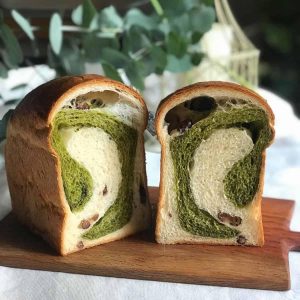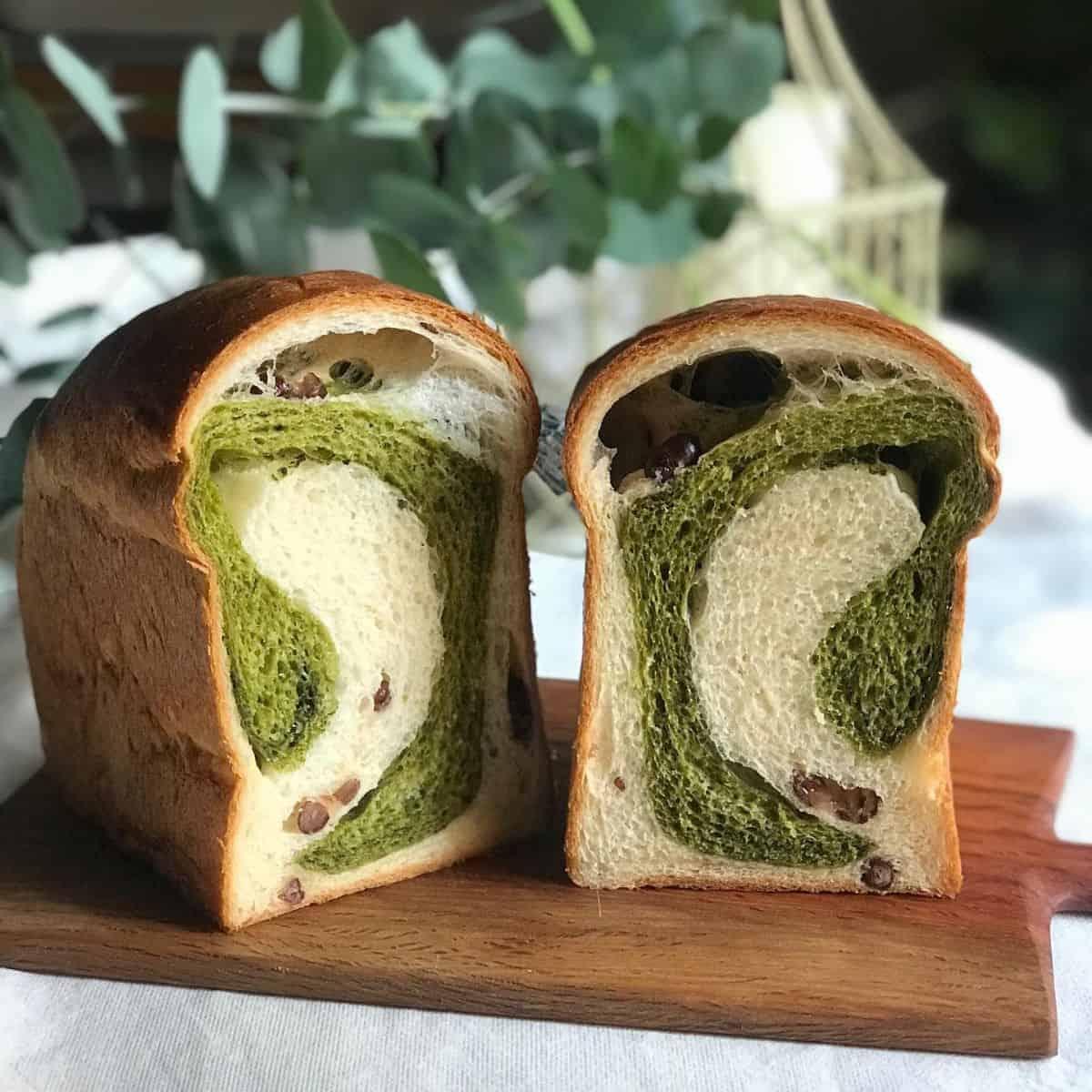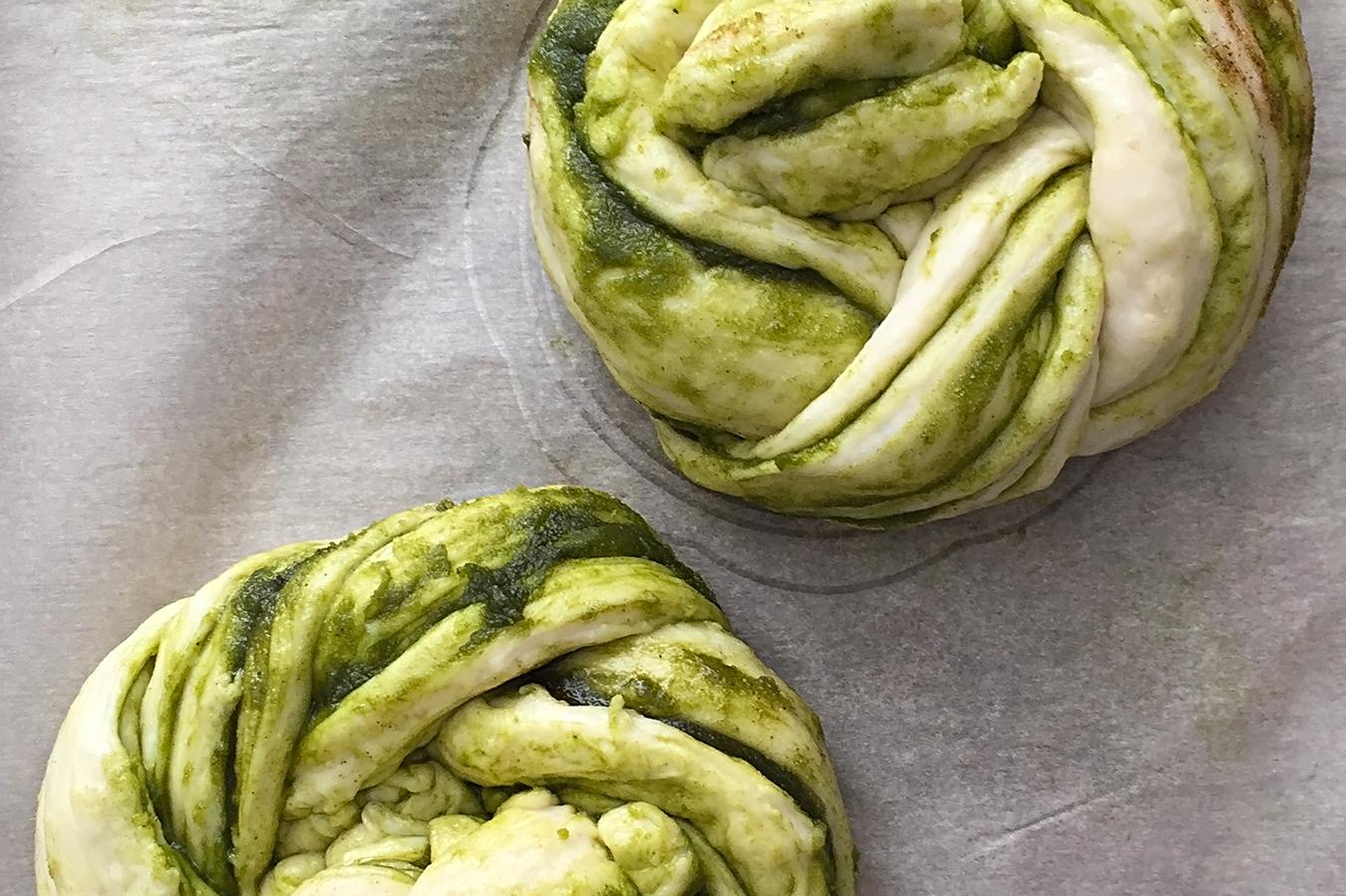Wanna impress your guests or your familly? Make this bread then! The marble effect is beautiful and sophisticated and you won’t believe how easy it is to make it! The Matcha marble asian bread is also egg-free, dairy-free and vegan-friendly.
I am filming a video of this recipe because I think it’s easier to understand! Will post in the upcoming days on my Instagram page. Stay posted!
Introduction about Matcha marble asian bread

If you’re following the recipe below, please make sure to follow all the steps! Please remember that any replacement will end in different result!
This matcha version is my favorite for breakfast! High quality matcha powder is such a great booster!
To make this bread I used the bread starter method (or Tangzhong method) which allows the bread to keep fresh for longer on the counter. Highly recommended!
The beautiful pattern is simply made by stacking up alternated layers of matcha and plain dough. The dough is then divided into 3 equal stripes and shaped into a 3 strand braid.

Matcha marble asian bread
Equipment
- 20 cm loaf pan, stand miyer with hook attachment (recommended, but can be knead by hand)
Ingredients
Ingredients for the starter (tangzhong)
- 45 g bread flour
- 240 ml (1 cup) water
Ingredients for the dough
- 440 g bread flour
- 2 g instant yeast (or 1 pack active dry yeast)
- 30 g light brown sugar
- 3,5 g (1/2 tsp) fine salt
- 45 ml full fat soy milk room temperature
- 100 ml water room temperature
- 30 g vegan butter (or regular butter) softened
- 4 g (1/2 tbsp) matcha powder
Instructions
Make the starter
- Add water and flour in a small pan. Whisk to dissolve. Cook on medium heat until the mixture starts to thicken. Let cool down completely before using.
Make the dough
- In the bowl of a stand mixer whisk dry ingredients except matcha powder.
- Add water, milk and tangzhong and knead until just combined. Cover with plastic wrap and let rest for 5 min.
- Add butter and knead with hook attachment until smooth and elastic (about 10-15 minutes).
- Divide dough into 1/3 and 2/3 portions. Shape the 2/3 piece into a ball and place into a greased bowl. Cover and set aside.
- Add matcha powder to the remaining 1/3 dough and knead to combine. Cover and let rest until doubled in size (1h- 1h30).
- Roll out plain dough into a 20x30cm rectangle. Roll out cacao dough into a 20x15cm rectangle. Place cacao dough over one half of plain dough and fold the remaining plain dough over.
- Roll out into a 20×30 cm rectangle again. Cut dough cross wise and stack the two doughs. Roll out to combine. Repeat two more times
- Cut dough into 3 equal stripes, lengthwise. Roll out each stripe into a rope and braid the 3 ropes together.
- Fold ends under so that the bread fits the pan. Let rise for 1 h.
- Preheat oven to 175C degrees and bake for 25 minutes. Brush with melted butter. Let cool down into the pan for 15 min then cool completely on a rack.
Video
Nutritional ingredients

The nutritional ingredients of matcha marble Asian bread may vary depending on the recipe, but here are some common ingredients and their nutritional values:
- Flour: Flour is a source of carbohydrates and provides energy. It also contains small amounts of protein and fiber.
- Sugar: Sugar is a source of carbohydrates and provides energy. It does not contain any significant vitamins or minerals.
- Matcha powder: Matcha powder is made from ground green tea leaves and is a rich source of antioxidants called catechins. It also contains small amounts of caffeine and L-theanine.
- Milk: Milk is a source of protein, calcium, and vitamin D.
- Eggs: Eggs are a source of protein and contain a wide range of vitamins and minerals, including vitamin D, vitamin B12, and selenium.
- Butter: Butter is a source of fat and provides a rich, buttery flavor to baked goods.
- Yeast: Yeast is a type of fungus that helps bread to rise. It does not contain any significant vitamins or minerals.
Overall, matcha marble Asian bread is a relatively high-carbohydrate food that provides energy. It also contains small amounts of protein, fat, and various vitamins and minerals depending on the specific recipe.
AQs of Matcha marble asian bread

Here are some frequently asked questions (FAQs) about matcha marble Asian bread:
Q: What is matcha marble Asian bread?
A: Matcha marble Asian bread is a type of sweet bread that incorporates matcha (green tea) powder into the dough to create a marbled effect. It is a popular baked good in Japan and other Asian countries.
Q: Is matcha marble Asian bread healthy?
A: Matcha marble Asian bread can be a tasty treat but it is not necessarily considered a healthy food. It is typically high in carbohydrates and sugar, and may contain added fats like butter. However, matcha powder does provide antioxidants and other health benefits.

Q: Can I make matcha marble Asian bread without eggs or dairy?
A: Yes, it is possible to make matcha marble Asian bread without eggs or dairy. Vegan versions of the recipe may use substitutes like applesauce or flaxseed to replace the eggs, and non-dairy milk like almond milk to replace regular milk.
Q: How do I achieve a marbled effect in the bread?
A: To achieve the marbled effect in the bread, the matcha powder is typically mixed into a portion of the dough and then layered or swirled into the rest of the dough before baking. The exact method may vary depending on the recipe.
Q: How long does matcha marble Asian bread stay fresh?
A: Matcha marble Asian bread can stay fresh for up to a few days if stored properly in an airtight container at room temperature. It may also be frozen for longer storage. However, the freshness and texture may deteriorate over time.
